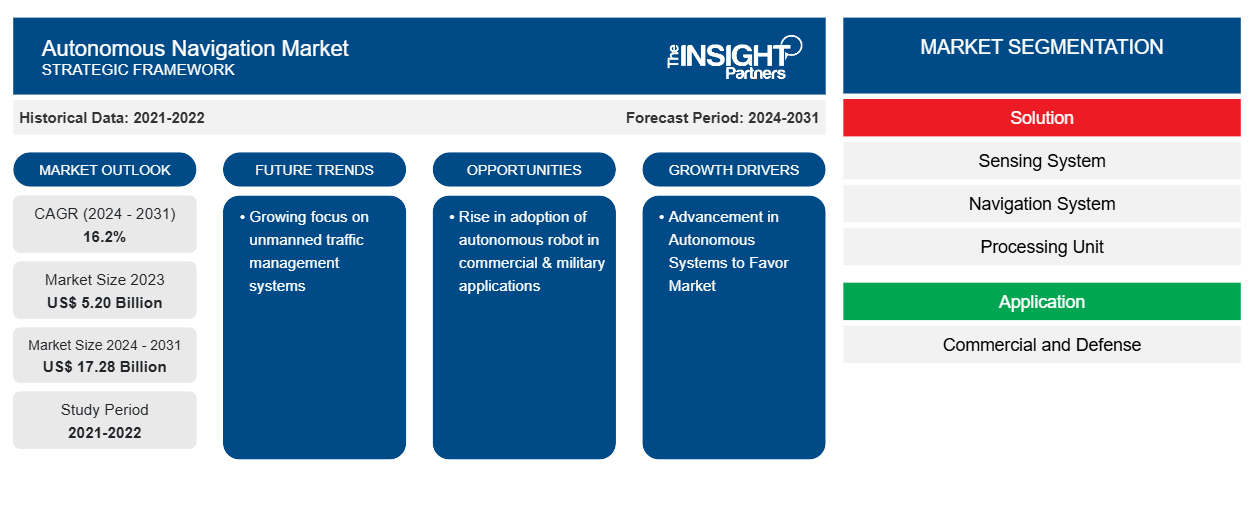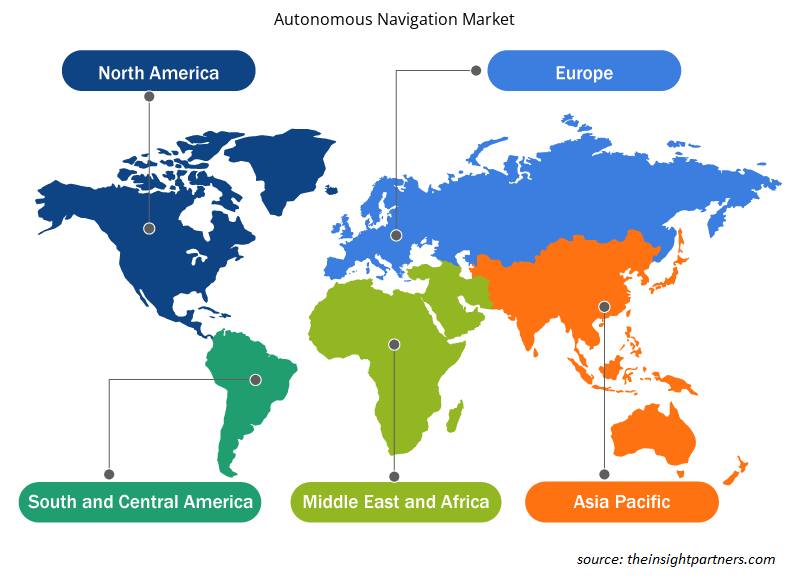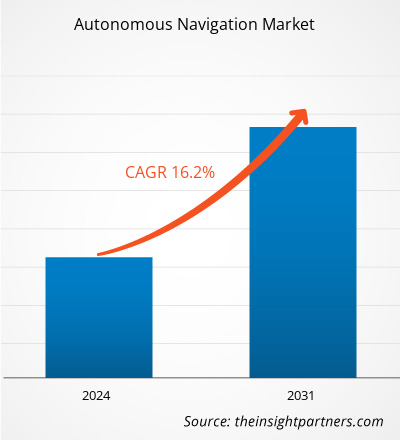The global autonomous navigation market size is expected to grow from US$ 5.20 billion in 2023 to US$ 17.28 billion by 2031; it is anticipated to expand at a CAGR of 16.2% from 2024 to 2031. The growing focus on unmanned traffic management systems is likely to remain a key autonomous navigation market trends.
Autonomous Navigation Market Analysis
The ongoing attempts to advance autonomous systems have been a crucial driver in the autonomous navigation sector. The development of advanced autonomous navigation systems for a variety of platforms, including aerial, terrestrial, marine, and space, has helped to drive market expansion.
Autonomous Navigation Market Overview
An autonomous navigation system is a complex technology that allows vehicles such as drones, robots, automobiles, and boats to plan and execute their itineraries without the need for human interaction. This system uses a combination of complicated technologies, including inertial navigation, satellite navigation, radars, cameras, ultrasonic and acoustic navigation, as well as powerful algorithms, to make intelligent judgments depending on the surrounding environment. Using these cutting-edge technology, the autonomous navigation system guarantees that cars navigate precisely and securely.
Customize This Report To Suit Your Requirement
You will get customization on any report - free of charge - including parts of this report, or country-level analysis, Excel Data pack, as well as avail great offers and discounts for start-ups & universities
Autonomous Navigation Market: Strategic Insights

- Get Top Key Market Trends of this report.This FREE sample will include data analysis, ranging from market trends to estimates and forecasts.
You will get customization on any report - free of charge - including parts of this report, or country-level analysis, Excel Data pack, as well as avail great offers and discounts for start-ups & universities
Autonomous Navigation Market: Strategic Insights

- Get Top Key Market Trends of this report.This FREE sample will include data analysis, ranging from market trends to estimates and forecasts.
Autonomous Navigation Market Drivers and Opportunities
Advancement in Autonomous Systems to Favor Market
Technological improvements and intensive study have contributed significantly to the evolution of autonomous navigation systems. These improvements have resulted in the widespread use of autonomous vehicles, drones, and robotic systems in a variety of industries, including transportation, logistics, agriculture, and manufacturing. The expanding technology breakthroughs in the autonomous navigation business provide various prospects for autonomous car makers. The proximity to big automobile markets, such as the United States, as well as trade agreements like the North American Free Trade Agreement (NAFTA), help to drive the expansion of the autonomous navigation sector.
Rise in the adoption of autonomous robots in commercial & military applications
The accessibility, faster service, and dependable qualities of e-commerce platform-based businesses have considerably accelerated the expansion of the e-commerce sector. This expansion may be ascribed to a variety of causes, including technological breakthroughs and ongoing research and development in robotics, computer vision, artificial intelligence, and edge computing. Autonomous robots play an important part in military applications. They are used in a variety of combat support tasks, including anti-submarine warfare, mine laying, fire support, electronic warfare, battle damage management, strike missions, aerial refueling, and more. These robots help military forces throughout the world by replacing human scouts and doing jobs that are too risky or difficult for people to complete.
Autonomous Navigation Market Report Segmentation Analysis
Key segments that contributed to the derivation of the autonomous navigation market analysis are solution, application, vehicle type, and platform.
- Based on solution, the market is divided into sensing system, navigation system, processing unit, and software. The sensing system segment held a larger market share in 2023.
- In terms of application, the market is bifurcated into commercial and defense. The commercial segment held a larger market share in 2023.
- Based on vehicle type, the market is divided into AGVs, Mobile Robots, UUVs, Drones, and Others. The AGVs segment held a larger market share in 2023.
- Based on platform, the market is divided into land, marine, and space. The land segment held a larger market share in 2023.
Autonomous Navigation Market Share Analysis by Geography
The geographic scope of the Autonomous Navigation market report is mainly divided into five regions: North America, Asia Pacific, Europe, Middle East & Africa, and South America/South & Central America. North America dominated the Autonomous Navigation market in 2023. This is due to the rising demand for automated transport has been a significant driver of the autonomous navigation market in North America. As industries and consumers seek more efficient and reliable transportation solutions, the demand for autonomous navigation systems has increased.
Autonomous Navigation Market Regional Insights
The regional trends and factors influencing the Autonomous Navigation Market throughout the forecast period have been thoroughly explained by the analysts at The Insight Partners. This section also discusses Autonomous Navigation Market segments and geography across North America, Europe, Asia Pacific, Middle East and Africa, and South and Central America.

- Get the Regional Specific Data for Autonomous Navigation Market
Autonomous Navigation Market Report Scope
| Report Attribute | Details |
|---|---|
| Market size in 2023 | US$ 5.20 Billion |
| Market Size by 2031 | US$ 17.28 Billion |
| Global CAGR (2024 - 2031) | 16.2% |
| Historical Data | 2021-2022 |
| Forecast period | 2024-2031 |
| Segments Covered |
By Solution
|
| Regions and Countries Covered | North America
|
| Market leaders and key company profiles |
Autonomous Navigation Market Players Density: Understanding Its Impact on Business Dynamics
The Autonomous Navigation Market is growing rapidly, driven by increasing end-user demand due to factors such as evolving consumer preferences, technological advancements, and greater awareness of the product's benefits. As demand rises, businesses are expanding their offerings, innovating to meet consumer needs, and capitalizing on emerging trends, which further fuels market growth.
Market players density refers to the distribution of firms or companies operating within a particular market or industry. It indicates how many competitors (market players) are present in a given market space relative to its size or total market value.
Major Companies operating in the Autonomous Navigation Market are:
- BlueBotics SA
- YUJIN ROBOT Co., Ltd.
- KONGSBERG
- Trimble Inc.
- ASI Robots
- Collins Aerospace
Disclaimer: The companies listed above are not ranked in any particular order.

- Get the Autonomous Navigation Market top key players overview
Autonomous Navigation Market News and Recent Developments
The autonomous navigation market is evaluated by gathering qualitative and quantitative data post primary and secondary research, which includes important corporate publications, association data, and databases. The following is a list of developments in the market:
- In June 2022, BlueBotics launched ANTdriven.com, a new educational resource aimed at helping professionals start their AGV (Automated Guided Vehicle) journeys. The platform provides clear and helpful educational content and useful tools and even offers free expert consultancy. It is designed to assist potential buyers in overcoming challenges and finding the best-fit automated vehicles for their businesses. ANTdriven.com features a wide range of content to suit every visitor, regardless of where they are on their AGV journey.
(Source: BlueBotics, Press Release, 2022)
Autonomous Navigation Market Report Coverage and Deliverables
The "Autonomous Navigation Market Size and Forecast (2021–2031)" report provides a detailed analysis of the market covering below areas:
- Market size and forecast at global, regional, and country levels for all the key market segments covered under the scope
- Market dynamics such as drivers, restraints, and key opportunities
- Key future trends
- Detailed PEST/Porter's Five Forces and SWOT analysis
- Global and regional market analysis covering key market trends, major players, regulations, and recent market developments
- Industry landscape and competition analysis covering market concentration, heat map analysis, prominent players, and recent developments
- Detailed company profiles
Frequently Asked Questions
What are the driving factors impacting the global autonomous navigation market?
The growing efforts aimed at advancing autonomous systems have been a significant driver for the autonomous navigation market.
What are the future trends of the global autonomous navigation market?
The growing focus on unmanned traffic management systems is likely to remain a key autonomous navigation market trends.
Which are the key players holding the major market share of the global autonomous navigation market?
The key players holding the majority of shares in the global autonomous navigation market are BlueBotics SA, YUJIN ROBOT Co., Ltd., KONGSBERG, Trimble Inc., and ASI Robots.
What is the estimated market size for the global autonomous navigation market in 2023?
The autonomous navigation market size is expected to grow from US$ 5.20 billion in 2023 to US$ 17.28 billion by 2031; it is anticipated to expand at a CAGR of 16.2% from 2024 to 2031.
What will be the market size of the global autonomous navigation market by 2031?
The global autonomous navigation market is expected to reach US$ 17.28 billion by 2031.
- Historical Analysis (2 Years), Base Year, Forecast (7 Years) with CAGR
- PEST and SWOT Analysis
- Market Size Value / Volume - Global, Regional, Country
- Industry and Competitive Landscape
- Excel Dataset
Testimonials
Reason to Buy
- Informed Decision-Making
- Understanding Market Dynamics
- Competitive Analysis
- Identifying Emerging Markets
- Customer Insights
- Market Forecasts
- Risk Mitigation
- Boosting Operational Efficiency
- Strategic Planning
- Investment Justification
- Tracking Industry Innovations
- Aligning with Regulatory Trends
Yes! We provide a free sample of the report, which includes Report Scope (Table of Contents), report structure, and selected insights to help you assess the value of the full report. Please click on the "Download Sample" button or contact us to receive your copy.
Absolutely — analyst assistance is part of the package. You can connect with our analyst post-purchase to clarify report insights, methodology or discuss how the findings apply to your business needs.
Once your order is successfully placed, you will receive a confirmation email along with your invoice.
• For published reports: You’ll receive access to the report within 4–6 working hours via a secured email sent to your email.
• For upcoming reports: Your order will be recorded as a pre-booking. Our team will share the estimated release date and keep you informed of any updates. As soon as the report is published, it will be delivered to your registered email.
We offer customization options to align the report with your specific objectives. Whether you need deeper insights into a particular region, industry segment, competitor analysis, or data cut, our research team can tailor the report accordingly. Please share your requirements with us, and we’ll be happy to provide a customized proposal or scope.
The report is available in either PDF format or as an Excel dataset, depending on the license you choose.
The PDF version provides the full analysis and visuals in a ready-to-read format. The Excel dataset includes all underlying data tables for easy manipulation and further analysis.
Please review the license options at checkout or contact us to confirm which formats are included with your purchase.
Our payment process is fully secure and PCI-DSS compliant.
We use trusted and encrypted payment gateways to ensure that all transactions are protected with industry-standard SSL encryption. Your payment details are never stored on our servers and are handled securely by certified third-party processors.
You can make your purchase with confidence, knowing your personal and financial information is safe with us.
Yes, we do offer special pricing for bulk purchases.
If you're interested in purchasing multiple reports, we’re happy to provide a customized bundle offer or volume-based discount tailored to your needs. Please contact our sales team with the list of reports you’re considering, and we’ll share a personalized quote.
Yes, absolutely.
Our team is available to help you make an informed decision. Whether you have questions about the report’s scope, methodology, customization options, or which license suits you best, we’re here to assist. Please reach out to us at sales@theinsightpartners.com, and one of our representatives will get in touch promptly.
Yes, a billing invoice will be automatically generated and sent to your registered email upon successful completion of your purchase.
If you need the invoice in a specific format or require additional details (such as company name, GST, or VAT information), feel free to contact us, and we’ll be happy to assist.
Yes, certainly.
If you encounter any difficulties accessing or receiving your report, our support team is ready to assist you. Simply reach out to us via email or live chat with your order information, and we’ll ensure the issue is resolved quickly so you can access your report without interruption.





















 Get Free Sample For
Get Free Sample For